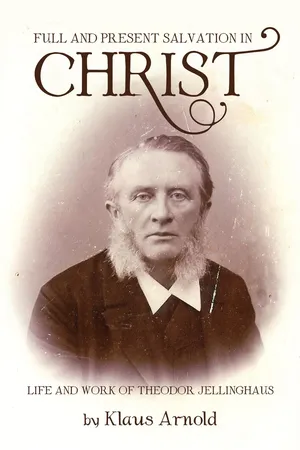![]()
1
Introduction
The nineteenth century, and especially the last quarter of it, bears witness to interesting connections and relationships (most of which were reciprocal) in the history of Protestantism between the United Kingdom and the European continent and even the United States of America. One outstanding example is the history and impact of the holiness movement.
This work deals with that movement in general and one of its protagonists in particular, Rev. Theodor Jellinghaus. He was a Lutheran Pietist minister, missionary to India, founder of a Bible school, author of a theological treatise and other publications, speaker at various holiness conferences, theological leader of the Heiligungsbewegung and one of the characters at the beginning of the Gemeinschaftsbewegung in Germany, a nineteenth century development of the Pietist tradition in Germany.
Motive and Goal of the Work
I learned about the work and life of Theodor Jellinghaus during my theological studies. Since I belong to a denomination which has emanated from the American holiness movement, I became fascinated that a German theologian in the nineteenth century tried to build a bridge between Anglo-American and German theological traditions in relation to the doctrine of sanctification.
After starting with serious research I had the chance to meet some of Theodor Jellinghaus’s family, which gave me another boost of motivation for the work. After the death of Dr. Paul Jellinghaus, son of Theodor Jellinghaus and successor of his work, the descendants had decided that the family member with the most interest in the family history should keep the family archives. Because of the total destruction of Berlin during the Second World War most of the archives were lost and destroyed. I had the privilege of meeting Mr. Sigmar Jellinghaus, great-grandson of Theodor Jellinghaus, who has given me access to what was left from the archives.
It is the goal of this work to examine and assess the life and work of Theodor Jellinghaus. Jellinghaus was the only representative of the Heiligungsbewegung in Germany who wrote a theological treatise of his understanding of sanctification in relation to other major doctrines of the church. His scholarly contribution was formulated especially in his seven-hundred-and-thirty page magnum opus, Das völlige, gegenwärtige Heil durch Christum (The Full, Present Salvation through Christ), which went through five editions between 1880 and 1903.
The key event for the life and work of Jellinghaus was his participation inthe convention on Christian holiness in Oxford in 1874. Therefore, the approach taken in this work will be to examine the historical context before examining his theology. He wanted to bring the new insights he gained there to revive the Protestant and Pietist traditions in the land of the Reformation. He believed that the doctrine of sanctification by faith in Jesus Christ which he had heard in England was an indispensable consequence of and necessary accompaniment to a clear doctrine of justification by faith in Jesus Christ. His doctrine of salvation focused on a personal faith relationship of the believer with Jesus Christ. In justification the relationship was established by the grace of God through the Holy Spirit; and in sanctification it was sustained through the Holy Spirit in moment-by-moment yielding of the believer to God.
Once he had formulated his doctrine of justification and sanctification, Jellinghaus developed the doctrines of redemption and reconciliation. In fact, the latter became the ontological foundation of his teachings because it provided the basis for both the objectivity and subjectivity of salvation in the person and work of Jesus Christ. It will be demonstrated that his teachings were a distinctive treatment of different influences in his life and learning.
Although the ecclesiology of Jellinghaus was based on the understanding of the established Protestant Church in Germany and rooted in the historical and theological development of the Pietist tradition in Germany (ecclesiola in ecclesia), he developed an ecclesiological concept which received an independent character through his doctrines of reconciliation and redemption. This approach and the fact that he formulated his theological understanding in a theological treatise made him unique among the fathers of the Gemeinschaftsbewegung. The involvement of Jellinghaus in the Gemeinschaftsbewegung must be interpreted from the viewpoint of his ecclesiological concept in the light of his understanding of the kingdom of God and in relation to the Protestant state churches of Germany. His special concern in the Gemeinschaftsbewegung was the education of laypersons.
The last phase of his life was characterized by crisis and illness which were related to each other and directly and indirectly led to hisso-called recantation. We can only do justice to the overall persona of Jellinghaus if we differentiate between the former (healthy) and later (ill) Jellinghaus. He has to be viewed in the contradictions and tensions within the development of the Heiligungsbewegung and the Gemeinschaftsbewegung as well as his theological teachings.
This work is the first comprehensive treatment of Jellinghaus which not only focuses on his doctrine of sanctification, but assesses his overall life and work, that is, his theological system and personal involvement in and contribution to the development of the Heiligungsbewegung and Gemeinschaftsbewegung in Germany.
Methodology
A mix of biographical study and thematic approach seems to be the best method to look at the life and work of Theodor Jellinghaus. The main themes of his theological thought and his contribution to the Heiligungsbewegung and Gemeinschaftsbewegung in Germany can only be understood in the framework of important events and developments in his life. From his family background, studies, and experiences as missionary in India and pastor at two different parishes in Germany to the encounter with leading persons of nineteenth century Pietism in Germany and representatives of the American holiness movement during a holiness conference in England and the following development of the Heiligungsbewegung and Gemeinschaftsbewegung in Germany cannot be separated from the formulation of his theological teachings.
There are at least three strengths in this approach. First, it places Jellinghaus in the historical-theological setting of the ...
